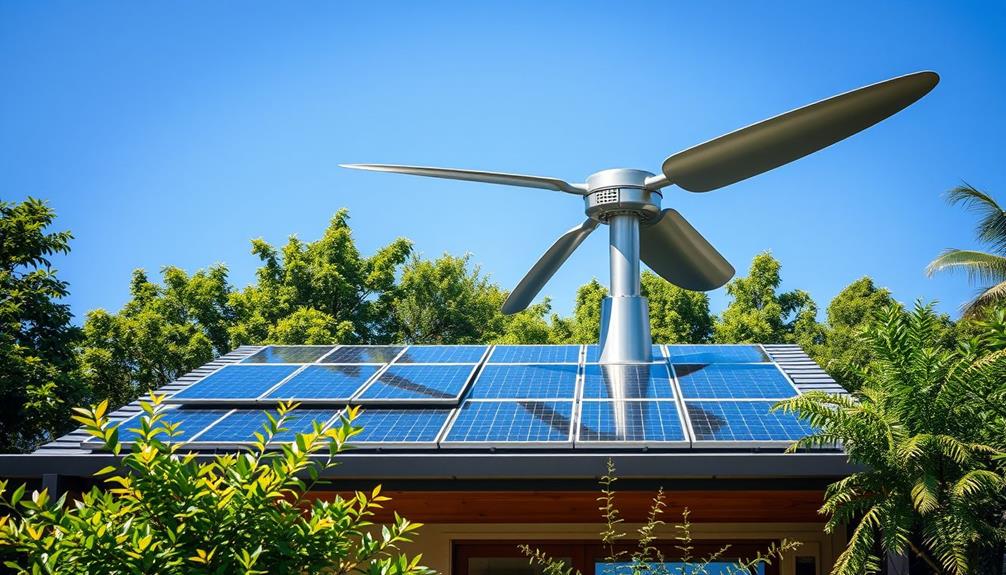Putting a small wind electric system in your home can change how you use energy. It brings sustainable power and lowers your energy bills. Small wind turbines for homes vary from 400 watts to 20 kilowatts1. This variety means you can find the right size for your energy needs, big or small.
Wind power lets you use renewable energy, lessening your need for traditional power sources. A typical home uses about 10,649 kilowatt-hours of electricity yearly, or 877 kilowatt-hours a month1. A right-sized wind turbine could cover a big part of your electricity use. It might even produce extra energy.
A 1.5-kilowatt wind turbine can supply a home using 300 kilowatt-hours a month in areas with 14 mile-per-hour winds1. This shows how wind energy can efficiently power your home.
Where you place a wind turbine matters a lot. A turbine on a hill catches more wind than one in a sheltered spot1. Good placement means more wind captured and more electricity made.
Maintenance for a small wind electric system includes yearly checkups. You’ll need to tighten bolts, look for rust, and replace any worn parts1. With the right care, these systems can last over 20 years1. This proves their reliability and long-term value for your home.
Using a wind turbine at home has many advantages. It cuts your carbon footprint, makes you less dependent on the grid, and can lower your electric bill. With proper care and setup, these systems can serve you for many years, offering sustainable energy.
Planning for a Wind Turbine at Your House
Installing a wind turbine at your house requires careful planning. First, check the wind at your site. Also, look into local zoning laws and what the project will cost you. Understanding these will help you decide if a wind turbine is right for you.
Assessing Wind Resources at Your Site
The success of a wind turbine at your home depends on the wind’s strength2. You need a steady wind to generate power. The wind can change based on things like terrain and nearby trees. To figure out the wind’s pattern, use maps from the U.S. Department of Energy’s WINDExchange. You can also set up systems to measure the wind speed at your place2.
Zoning Requirements and Covenets
Understanding local rules is key when planning for a wind turbine. Many places limit how tall structures can be. Knowing these rules will help you avoid problems when you install your turbine2.
Economics, Payback, and Incentives
Think about the money side of adding a wind turbine. The cost to install one can be between $50,000 and $80,0003. Plus, consider the charge to connect your turbine to the power grid. This could be $15,000 to $50,000 per mile, based on the landscape3.
Wind turbines work best around 40% of the time3. They might not produce power at all for about 60% of the time3. Before you decide, know how much power you might get. Look into any tax breaks or rebates too. These can help with the costs3.
Plan carefully by considering the wind, local rules, costs, and available incentives. This ensures you get the most from a wind turbine. It’s a step towards using renewable energy at home.
Siting a Wind Turbine at Your House
When you think about putting a wind turbine at your home, finding the best spot is key. You want a place with lots of wind for more power. It’s crucial to think about wind patterns, where to put the turbine to catch more wind, and how tall to make the tower.
Wind Resource Considerations
Before setting up a wind turbine, check the wind in your area to see if it’s strong enough. Look at which way the wind usually blows, how fast, and how steady it is. You’ll need to find a spot without too many trees or buildings that could block the wind.
About 40% of all wind energy in Europe is found in the UK4. You’ll need wind speeds of at least 6 meters per second for a home turbine to work well4. This info can help you pick the best place for it.
System Considerations
Picking the right wind turbine for your needs is important. Think about how much power you need. Small turbines can come in sizes from 1-kilowatt to 100-kilowatt5. Micro turbines last about 10–15 years and are good for small jobs like charging RV batteries6. A 2.5kW turbine might be able to power your whole house for a year4.
Upwind Siting
Make sure to place your turbine upwind of any barriers. This way, it catches more wind. Knowing which way the wind blows most often will help you set it up right. Putting it downwind of obstacles could lower the amount of power you get.
Height of Tower
The tower’s height matters a lot for catching good wind. Most wind turbine towers are about 300 feet tall5. This height helps them reach stronger winds. Choosing how tall to make your tower depends on the land around it and how the wind blows there.
By thinking about wind conditions, the right system, where to place the turbine, and how tall to make the tower, you can find the perfect spot. This makes sure your wind turbine does its best to turn wind into clean energy6.
Sizing a Wind Turbine for Your House
Choosing the right wind turbine size for your house is key. First, think about how much electricity you use and your budget for energy. You should also consider improving your home’s energy efficiency. This can lower how much energy you need, affecting the turbine’s size. The height of the turbine is also important for how much power it makes.
Electricity Demand and Energy (Budget
To find the best wind turbine size, you need to know your home’s energy use and what you can spend. For instance, if your home uses 10,000 kWh of electricity a year, your turbine should at least match this. This ensures it covers your energy needs7.
Tower Height and Wind Energy Capture
The turbine tower’s height greatly affects how much power your wind turbine will generate. The best height grabs the most wind, making more energy. Automaxx suggests a hub height of at least 20 feet for homes. For even better results, aim for a tower at least 100 feet tall8.
Capacity Factor and Annual Output
The capacity factor of a wind turbine is crucial. It shows the percentage of power it produces compared to its full potential. If a turbine has a 30% capacity factor, it means it works at 30% of its top ability on average. To figure out yearly output, multiply the turbine’s capacity by its capacity factor. A 10 kW turbine at 30% will produce about 3,000 kWh a year7.
Considerations and Recommendations
Several things matter when choosing a wind turbine for your home. These include where to put it, permits, its upkeep, your budget, backup power sources, and your area’s rules. Also, local wind speeds and how well the wind moves are key. Your turbine should stand at least 10 meters above any nearby trees to avoid wind disturbances. The ideal height is between 30-50 meters for the best wind conditions9.
Summary
It’s important to think about several factors when picking a wind turbine. Consider how much power you need, your budget, and how tall your turbine should be. By looking at all these points, you can pick the best turbine for your home’s energy needs.
| Statistical Data | Source |
|---|---|
| Annual electricity consumption example: If a home consumes 10,000 kWh of electricity annually, a wind turbine needs to generate at least this amount for power needs. | 7 |
| Hub height recommendation: Automaxx recommends a hub height of at least 20 feet for optimal performance in residential applications. | 7 |
| Capacity factor example: A wind turbine with a capacity factor of 30% will generate 30% of its rated capacity on average over time. | 7 |
| Annual output calculation example: A wind turbine rated at 10 kW with a 30% capacity factor will generate, on average, 3,000 kWh annually. | 7 |
| Wind turbine sizing example: For an annual consumption of 10,000 kWh and a 30% capacity factor, a wind turbine rated at 33,333 kWh is needed. | 7 |
| Generators for single houses are typically sized between 5 and 20 kilowatts. | 8 |
| The Department of Energy suggests that small wind installations become economical with an average annual wind speed of about 10 miles per hour (4 meters per second). | 8 |
| An acre of land is considered the minimum space required for a home wind turbine, with more land being preferable. | 8 |
| Home wind turbines are generally recommended to be at least 100 feet (30 meters) tall for optimal wind energy capture. | 8 |
| A wind turbine may be cost-effective for a home with an electricity cost per kilowatt-hour of at least 12 cents and a monthly electric bill of $100-150. | 8 |
| A generator with a capacity of 10 kilowatts is suitable for a house ranging from 2,000 to 2,500 square feet. | 8 |
| Much data will be added in updates |
Estimating Energy Output of a Wind Turbine
Figuring out how much energy a wind turbine can make in a year helps decide if it’s right for you. Experts can estimate how much energy it will produce. They look at the turbine’s power curve, the average wind speed, how tall the tower is, and how often the wind blows at different speeds.
Horizontal-axis turbines usually do a better job than vertical-axis ones in turning wind into electricity. Their efficiency is about 30-40%10. But it should not go over the Betz limit, which is 59.3%1011. This takes into account various things that can reduce efficiency, like mechanical and electrical issues.
Turbines can lose a tiny bit of power through their blades and gearbox, about 0%-0.3%1011. Electrical losses usually range from 1%-1.5%. Moreover, the power can drop by 3%-10% when it’s sent to the grid1011. Keep these losses in mind to understand a turbine’s total power output.
How often the wind blows and its average speed are key to figuring out power output. Wind speeds usable for energy range from 3-25 m/s1011. A place with steady and strong winds will make more electricity.
The taller the tower, the more energy you can make10. Tall towers catch stronger winds. The right tower height depends on how the wind acts at your site.
You can work out how much money a wind turbine makes by multiplying the tariff by its power output10. Turbines can make anywhere from 1.8-90 kWh of energy daily, depending on their design10. For instance, a 500W turbine could make about 9 kWh in a day10. These numbers help get a sense of possible earnings.
Remember, wind turbines cost money at the start. They can be priced between $2 million to $4 million. Maintenance might cost an extra $50,000 after buying10. It’s essential to consider these expenses when thinking about the benefits and the return on investment of a wind turbine.

| Factor | Range | |
|---|---|---|
| Turbine Efficiency | 30% | 40% |
| Blade & Gearbox Mechanical Losses | 0% | 0.3% |
| Turbine Electrical Losses | 1% | 1.5% |
| Transmission to Grid Electrical Losses | 3% | 10% |
| Out of Order Time | 2% | 3% |
| Wind Power Availability | 3 m/s | 25 m/s |
| Energy Production (per day) | 1.8 kWh | 90 kWh |
| Energy Output of 500W Turbine (per day) | 9 kWh | |
| Cost of Wind Turbines | $2 million | $4 million |
| Maintenance Costs | $50,000 (post-purchase) | |
Connecting a Wind Turbine to the Grid
Grid-connected systems use wind energy and merge it with our electrical grid. Hooking up a wind turbine reduces the need for power from the utility. It uses wind’s sustainable energy instead.
When hooking up a turbine to the grid, making sure it fits with the grid is key. This makes it run smoothly. Having the grid as a backup is great for times when the turbine doesn’t make enough power.

The steps to connect a wind turbine to the grid are outlined in the turbine’s install manual. It suggests where to connect and how to wire it safely12. It recommends using special fittings to keep wires safe and protected from weather12.
Wires usually go down the turbine’s tower to a box12, then into your home12. Feed cables might be hidden in plastic or metal pipes12. Buried cable connections are popular as they’re cheaper and simpler12. Following NEC/CEC rules for cable protection and using disconnect switches is essential12.
Turbine makers might offer panels for easier setup and to avoid problems12. These panels help connect smoothly and make the turbine work well with the grid.
Grid-connected systems not only use wind power but can also send extra power back to the grid. If your turbine makes more electricity than you need, the extra can lower your future power bills or provide backup during outages. This keeps your power supply stable, even in bad weather.
Connecting your turbine to the grid helps make our power system more sustainable and clean. Wind power reduces harmful emissions and can cut your electricity costs. It makes renewable energy a good financial choice, too.
Advantages of Grid-Connected Wind Turbines:
- Reduced dependence on utility-supplied electricity
- Sustainable and environmentally friendly power source
- Ability to credit excess electricity towards future use or provide back-up power
- Contribution to a more sustainable and diversified energy mix
- Potential for substantial cost savings on electricity bills
Disadvantages of Grid-Connected Wind Turbines:
- Grid integration and compatibility considerations
- Ensuring compliance with NEC/CEC regulations
- Potential challenges in system operation and control
- System stability and power quality issues
Grid-Connected Wind Turbines: Power against a Sustainable Future
Integrating wind turbines with the grid leads us towards a greener future. By doing this, you help cut down on greenhouse gases and support clean energy. Adopting grid-connected wind power helps us move to a less polluted power system.
Wind Power in Isolated Grid Systems
Isolated grid systems stand apart because they don’t connect to the main electricity grid. This can make it hard, or very costly, to get power in these places. But, wind energy is an excellent power source for houses, farms, and communities off the grid. When mixed with solar panels, a hybrid system emerges. This system keeps energy flowing sustainably. It’s a big help especially for remote sites that need to stand on their own, far from utility lines.
Wind power systems that work off the grid often team up with solar panels. This helps when there’s not enough wind. This mix ensures power is always available, which is important in places where the weather changes a lot. In the colder months, it’s good to use gas or wood heating. This is because these heat sources use less electricity than electrical systems, which is great when wind speed drops.
Moving to a wind power system off-grid might mean changing how you live a bit. But, doing so can cut your electricity costs by1350%–90%. This is a huge save, especially when bringing power lines to you is expensive. Plus, these systems are a reliable backup for power outages, keeping things running smoothly.
Today, most small wind turbines have a design that includes two or three blades and faces into the wind. These blades are usually made of strong materials like fiberglass. How much power a turbine can make mostly depends on the size of its blades. Wind speed matters too. Although the NOAA map shows average wind speeds near the ground, wind is stronger up high. So, putting turbines higher up can really improve how they work, especially where wind is scarce.
Adding more turbines or better equipment can fix any lack of power in an off-grid system. By doing this, the system can meet all energy needs, even when the wind is weak. Plus, using less power and being more energy efficient helps too. These strategies make the most of your system, giving you the best results from your wind power.
If you want wind power but also a safety net, grid-tied systems are perfect. They use wind and solar power together, and have batteries for backup. This way, you always have power, even if the main grid goes down.
To start with wind power, there are turbine kits with everything you need. These kits make it easy to get going and can grow with your needs. They let you make a system that’s just right for you and your community.
| Benefits of Wind Power in Isolated Grid Systems | Considerations for Off-Grid Wind Power |
|---|---|
|

How Residential Wind Turbines Work
Residential wind turbines turn wind into electricity for your home. They use the force of wind on blades to make energy15. When the wind makes the blades spin, it drives a generator that produces power. This electricity powers your home’s appliances and devices.
It’s key to check if your home’s location is good for a wind turbine15. You need to look at wind patterns and speeds. A proper location check helps make sure the turbine works well and gets enough wind16.
There are many wind turbine designs for homes, including horizontal and vertical types15. Vertical-axis turbines are affordable and can work well in various spots15. You can install them on rooftops or on the ground.
Today’s wind turbines are much more efficient15. Even with winds as low as five mph, they can start making energy. They work best at wind speeds around 30 mph.
Wind turbines are great but need regular upkeep15. They can be noisy and only work well in certain wind conditions. Keeping them in top shape ensures they last long and work efficiently.
“Wind turbines have drawbacks such as the need for regular maintenance, noisy moving parts, and the requirement for suitable wind conditions for optimal operation.”
– Link 1
Horizontal-axis turbines might harm wildlife like birds and bats15. It’s important to think about this when you’re planning to install one.
Putting in a wind turbine can be complicated, so it’s best to get help from experts15. They know all about setting up the turbine, mounting it, and connecting it to your electrical system. They also make sure everything is done right according to the rules.
“Professionals are recommended for wind turbine installation due to complexities in site placement, physical mounting, and electrical system connection, along with the need for adherence to building codes and permits.”
– Link 1
Using wind turbines at home is a great way to get clean energy15. They are an eco-friendly alternative to fossil fuels. With the right setup and care, they can meet your energy needs and help the planet.

Pros and Cons of Wind Energy at Home
Wind energy is clean and renewable, perfect for home use. But, it’s important to weigh its pros and cons. This helps decide if wind energy is right for your home.
Advantages of Wind Energy
Wind energy plays a big role in moving towards clean energy in the U.S. It’s a great option for those who want to be eco-friendly. Here are its benefits:
- Clean Energy: Wind power is great for the environment. It doesn’t release harmful gases, helping us achieve a greener planet17.
- Energy Independence: Having a wind turbine at home means relying less on traditional energy sources. This step makes your home more sustainable18.
- Cost-Effective: Wind turbines have low upkeep costs. Thanks to free wind, you’ll save a lot on your electricity bills18.
Considerations and Challenges
While wind energy has many upsides, there are also downsides to consider:
- Wildlife Impact: Wind turbines can be dangerous for birds and bats. But, with the right technology and location, we can lessen this danger18.
- Noise: Wind turbines can be noisy, especially the older ones. Newer models, however, are much quieter, easing noise concerns17.
- Aesthetics: Some may not like how wind turbines look. Yet, they don’t take up much space, leaving room for activities like farming18.
Statistical Comparison
Let’s look at some numbers to understand wind energy better:
| Statistic | Wind Energy | Solar Energy |
|---|---|---|
| Average Cost per Kilowatt-Hour | $0.01-0.02 | – |
| Electricity Generation Capacity | 8% | 15% |
| Global Ranking of Cheapest Energy Source | 1st | – |
Note: The data in the table comes from multiple sources1819.
Wind energy is very affordable, with costs much lower than solar energy. It also makes up 8% of the U.S.’s renewable electricity. These facts show wind energy’s low cost and significance in the renewable energy scene.
Factors to Consider Before Installing a Wind Turbine
Thinking of installing a wind turbine at home? It’s important to look at several key factors first. This step makes sure your wind energy project works well and is cost-effective. Knowing what to consider will guide your decisions and bring out the best in wind power.
Weather Patterns and Wind Availability
Check the local weather and wind in your area first. The wind’s speed and how often it blows will tell you how much power you can make. Use wind maps and past data to find the best spot for catching the wind20. A wind turbine needs an average wind speed of 4 to 5 meters per second to work well20. Figuring out the wind can show if your spot is good for wind power.
Zoning Laws and Site Restrictions
Then, look into local zoning laws and site limits. Find out what rules you need to follow and what permits to get for a wind turbine20. Rules on how tall it can be, how much noise it makes, and how far from your home it needs to be can vary. Make sure your turbine fits the rules and won’t cause issues.
Turbine Reliability and Noise Levels
Choosing a reliable turbine is key. Look for brands known for lasting a long time and working well. The TESUP V7 wind turbine, for instance, can generate 7 kW of power and suits homes and small businesses21. It’s also quiet, making less noise than a vacuum cleaner21. Picking a quiet, reliable turbine makes your wind energy experience better.
Cost Considerations
Cost is very important too. Think about initial costs, upkeep, and any money-saving offers like the Residential Clean Energy Credit22. This credit can cover 30% of your costs. Also, consider how long it will take to pay off and the savings over time. This helps you see if a wind turbine is a smart money choice.
Do your homework, talk to experts, and look closely at your site before deciding. Keeping in mind weather, laws, the turbine’s reliability, and costs will guide you. Wind power can lessen your environmental impact and save money in the long run. By choosing wisely, you’ll take a big step toward a greener future.

Cost Considerations of Installing a Wind Turbine at Home
Thinking about installing a wind turbine at home means looking at different costs. These include the money you need upfront and money for keeping it running. Knowing these costs helps decide if wind energy is a good choice for your home.
The cost to put in a wind turbine can vary a lot. On average, you might spend $2,000, but it could go up to $80,000. For small turbines, the price ranges from $100 to $80,000. But, a big commercial turbine can cost as much as $4 million. A turbine for home use usually costs between $50,000 and $80,000.
Getting the right permits is also a key step. The process makes sure your turbine meets local rules and is safe. The cost for permits changes based on where you live. It’s important to check these costs ahead of time.
Remember to think about maintenance costs too. They can be between $42,000 to $48,000 a year. These costs ensure that your turbine stays in good shape. It’s a necessary part of your budget to plan for.
When planning your budget, think about how much energy you use. Typical homes use 800 to 900 kilowatt-hours a month. Wind turbines can cover a big part of this. Lowering your grid energy use can save you money over time.
So, installing a wind turbine at home includes different costs. There’s the initial price, permit fees, maintenance, and possible savings. Planning and understanding these expenses are key. This helps judge if a wind turbine is financially sensible for you.

| Cost Component | Range |
|---|---|
| Installation Cost | $2,000 – $80,00023 |
| Permitting Fees | Varies by jurisdiction |
| Maintenance Costs | $42,000 – $48,000 per year24 |
| Monthly Electricity Usage | About 800 – 900 kilowatt-hours |
Conclusion
Putting a wind turbine at your house can lead to great things. It helps us live cleaner and more sustainably. Wind energy is key to becoming energy independent and cutting down on carbon emissions. By using a wind turbine, you get clean electricity, help lower harmful gases, and support a healthier planet.
Recent numbers25 show that electricity from wind went up by 11% to 170 TWh in 2020. Wind energy now produces 1,592 TWh of clean power worldwide every year. It costs about US$31.45/MWh, making it a great deal compared to solar energy. Whether you choose a small turbine or a bigger one for your house, it’s a cost-effective way to power your home with clean energy.
Also, data26 tells us that wind energy will make up 24% of renewable electricity by 2035. With a worldwide capacity of 283,000 MW, wind turbines are being used more and more. Even though home values near turbines might dip a bit, the overall impact doesn’t seem to be large.
Based on the data27, small wind turbines for homes can last between 20 to 25 years. They save money on your energy bills over time. You’ll need average wind speeds of at least 12 miles per hour for best results. Installing a small turbine reduces your environmental impact and moves us towards a greener future.










